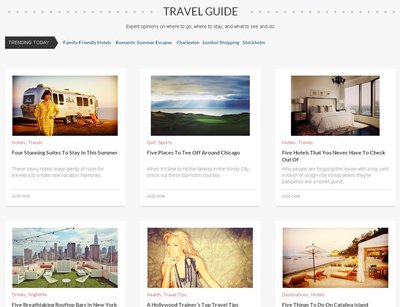Tourists traveling from China are proving to be a lucrative segment in terms of shopping spend and frequency of travel, according to a new report from China Luxury Advisors and Fung Intelligence Group.
Chinese tourists spend an average of $2,449 while away on a trip, which is 10 percent higher than tourists from other one-tier cities. Their frequency of travel is also greater than the standard with an average of 1.9 times a year per traveler, and 67 percent of tourists claiming to have traveled more than once in the past year.
"The key takeaway from this report is that the profile of the typical Chinese tourist is changing rapidly," said Renee Hartmann, cofounder of China Luxury Advisors, Los Angeles. "There are more individual Chinese tourists than ever before, and this is causing dramatic shifts in Chinese tourism traffic and spending patterns.
"Individual travelers are more likely to be younger, spend more on dining and experiences, prefer higher end hotels and are eager to visit new destinations off the typical Chinese tourist track," she said. "They are renting cars and driving themselves, staying in Airbnb and seeking more unique experiences such as wine tasting, cruises, helicopter tours, hot air balloons and new and different activities.
"This is bringing new opportunity to destinations that have not yet seen the boom of Chinese tourists. We expect this trend to continue, and for new destinations to benefit from increased individual travel from Chinese tourists this year and in the coming years."
Chinese travelers
While the potential with mobile in travel and hospitality is vast, Chinese tourists seem to be embracing it more so than any others. About 98 percent of tourists are using their mobile devices while away to keep in contact with friends and family.
However, 72 percent are using their phones to use a variety of platforms such as travel Web sites, blogs and social media to help organize their trips.

Forbes Travel Guide Web site. Image credit: Forbes
Overseas travel coming from China is continually growing with more Chinese traveling overseas this year than last. These tourists will likely result in about $315 billion in travel revenue in 2017 and see the biggest foreign travel spend in the world.
It is likely that 192 million outbound tourists from China will travel overseas by 2021 reaching a spend of $419 billion.
Currently, Japan is holding the place as the top destination for Chinese travelers with more than half of them traveling to the country.

Chinese tourists flock to Japan
In terms of farther distance destinations, Europe is the most visited location with 16 percent of Chinese travelers making the journey, followed by the United States with 9 percent.
The factor most driving decisions in regards to travel destination is security, followed by tourist spots and cuisine. Ninety-six percent of Chinese travelers said that security was an important factor in terms of destination, 94 said tourist spots and 88 percent claimed cuisine.
Additional insight
The United States is becoming a highly coveted travel destination among affluent Chinese consumers, and due to their spending habits the demographic has proven extremely influential, according to a report from YouGov.
Chinese affluent look to purchase luxury goods while traveling abroad, and Chinese consumers spend the most out of any group while traveling. YouGov's Affluent Perspective 2017: Chinese Luxury Shoppers in America finds that 56 percent of Chinese affluent are planning a trip to the U.S. within the next two years (see more).
Travel is an essential part of life for two-thirds of China’s outbound travelers, according to a report from Hotels.com.
The 2015 Chinese International Travel Monitor revealed that even with the economy sputtering, consumers plan to travel more and spend more while traveling than they have in the past. If China’s ballooning affluent and middle classes maintain this behavior, they can offer luxury brands a reprieve from the otherwise tumultuous times (see more).
"The most surprising finding is that Chinese tourists from second tier cities are actually spending more than those from first tier cities (see below statistic)," China Luxury Advisors' Ms. Hartmann said. "This is a new development and runs contrary to most brands and destinations marketing strategy of focusing on first tier cities.
"As brands and destinations widen their customer focus to include second tier cities, this will have a major impact on their advertising targeting, China retail strategy and product offerings tailored to consumers from second tier cities," she said.
{"ct":"621Kjsi3Zr\/BI63aLLqThMP+KeJI3yhWvtKlcMhQmUfEEdnVHpki+YgOaWPwXjKrF\/sQvvx\/49Su0EW1ZpiSXjvLB8zKxwbD6fHRpnIH2GRIfRVJ77nheZ26zjM04G7MrzAwoyG\/yY0tjctf+xdhemhmPF1u6w2pVM4qOFMudavehskXfBc2Tv1tA+Y4uCMQFBd82CuhTnXu6mjJ3hpfBhV5\/nICCX1XcVEvn0i1b5jc1RWV\/+Wwd9moWx+O9T1QlwY\/LU13FmnaX3aLfK4oYbTvITLIrIM31CyhBzAI3b1P6L+Foz\/tHPtKIZZjg\/hRx3RYKC0eiiLx5Y0lAM4KozHhqiftjhFxA5RnGAt3Pul2SlCUUPGZX1eICicfuMXDgHed1G5ZuvO3za2dwFaBEy7xMneLlmOz6U5IcVoucPS0RkfNq2QuJl9eEu5tzmCVrsOpNeIVGKcEeKeBkdAbTqjICb98RxCQJ0E\/ck8UCYNLgMz0AAcsAd3m1misogSE+mujZK5gJSi+tPnV+tbcbQD7TFzyhMzH4jU729NjgAG90kitetKw+lWvXHtsAvjjtQUyeF1\/WEW688ZxDo6Cgv9m\/965AyvbhCgfHqBEiX705\/ycbYZcNyUmJCJsT7yPl1syPeoXC3o1WTiStMhiwe2cZB8R22ClVgS6hD9Z4i1qALD5nv1shZny8YjVJIYd9hPTMZ6n80VXUutKiFhTehsu3lf6Y62GUpjEIXrptiuoBirH2sNbV6CtKttykq4lTaEH7eXgKCyE3WVhUJBfMR22x9cK4d\/QbYI1CybU\/RRhnYGD996FdsvtAO8YzgthysuxOlLXpupCMBFAj545BWjUxPMwHx6StmIPzc0MRJ5q2K5JZGQ1kREa\/98FXNaSShByh\/n4CSbaPgLfX+nlHyi6OYf5SoNeOnrAoKaK\/4T5NDuAv5f34zNr+6XVifNBNF5ly\/J5pmbMaujLeKiwEvO4l6Yq3AtK0\/IdL1TX39cPeNzFs85muOxAUA28m7SXZOaAPbeNpgAHqQK4frnPvLyqOscsal\/5RuhbaigGoLSfLM9djaETRYnH8lmxvo3NQ+ywmGuHUe8kjC+z0y54pNCkD4e4eqVpq3tnhIGgXWlC4Ok6u90bQM9RADdmKztSSL3qqCAOnladlTrx\/p1iwgakX55\/Bzb2bv5BtdYwwac8OhUOCrIGEnDkkFSsQ3R7XEwxAQYSdgfNG64LliwV23E5YIuLug8\/u2AjE1u6tvFJGNy5HeCqgoc04nSZeXsRjSnfsDZ+8GRz2dX7aNpiagZqVv6cmXwZzuJAm7BTf7XNJsQeouM4sXffUH31yMsh2wficQCQyk+dNEcqetGqsnvMofG2OFvhD3oqrwUxjlzF2c\/9MpTFYrGFucjpMhlbWzuSdfuUBpzq+NmJ6R0RBCr\/nD9CRHSMpFntR+kx0mxhj\/MDJkQi81i8gYfzL9qbu9EiB\/AJHPA9s9ridOjZFQXeI0r+a6+a5Rqcf64WWMqGDoGjzG90Pft0qdwTXfhcJmZugG+5\/rJ7gOVWqNuiH4TamFyCJI0UReNaZttJLPj1O19O9VFwrhUtH\/pDelgKDkkAeEST88AE4L3zAFXYbnz2YtIA3Jbh2ljgLaXpfrFk\/mV\/sPgB4Z7UCgccveKWibLPmq13veRBLFdIUqLjbpaJ+t3BvNL2W0Gqbl4CZ+Sjixw258yL8ZpbT8mfDw20Wcd569MkpluU0xFuvrs6qnjAGy\/U34t95OiuFW2qluvvuETBxfXAChxw\/bfmM8OZxOZMsVpuSS6GfztcZz\/J6ptdobxwsgbPakqVXduclrDvGnB77lUtSLa+L8NbnJXdXMvYzx+7NX9TQi24zkojTSx\/dcGChnRkzUO3mi7qKye\/HCOtycQTNyRUC9V921tkUeFCKuAhgWB7uYQ0DCaro1yOFRVWByZ40oNrnSCKW8J3uIlwY1raA0HYJrbISYgbcnMZIwy1eBdxmkazzR44uj+VYTZjtgu1G5eNOgmcC95NEvIb8tmCscFiamNsd8\/0HYi17HDzjOGiXO617zu0DtD4C\/72mQEMp9uQliPHPMQXTh1GQF5M99yQVnBuH\/O7S0k8hvXlqaVfb0itPVjg72gmzsRt8jx1QRWlgYqOiQ0cDqkgJW2J5ye16PNWCWcgeuVbPsCPlLIaoemEbSBAVobIkNBCuRbe+TVGIWTQVe+5hNfworrG5imGF3F28h+PFcEbZLrAE6ddj2OdTPeiEQpMpxo5+B0I247bRqdV9RiBtSVQFUH7MHfVd+IXoiNonH+6yeWB58DH8IAtIqmuVoTL2Pg9qPjed+QC0nAVCkF\/D8I57wPqYKnBU8FOMSYGbirLRBu7sn5f6cemTtaxar8sEy+Cvrs5AssQNAxsy\/FlP3F\/eiE42mP5lnig9bPbDj535NAgJ3yKB6boUHNu7Qcq2xy15luwlrdYVUWjz1AAVeR3cWhptkq4EkQ8LgziR58BuNfrlIVWOXE8+sZInrXdxNsX4Uu0EaJRAR9ptQ7YWiSOULH2w5xGXmbO1azLuyYp\/xLFP6H0iyWtlbqeX3L4YHPR92FIGRaxXjOQTtot0IjeZsiikWRJ\/kVH\/YK0Bjh3JuWJy\/v23NjukJPJJcW5AZyGe1eGzZrCVpAWryk3mzDmbY0XvGqMysL5D3s\/7N9oTq045mgLsNgWML3dqc56olY+vzxabYRiEYC\/ZRokFoBrBFJ1+Wu1XNZQrcvhlGHzNBF7EK3b4ZTMNEO8njW+vjtnnRkCMZqFehfEWD4t0B37FziITcASodBkNLX8N0LygNrJ+ZKg0e1NwiKCpHZvWQb5+sFzUOdWwJtcBBOvL1rrYIfc0j44zfsVs\/pV4h8chOhv8J3oaa3P6zOyD2kHvFySyL++XPDWk5Vd\/L1lH8yvPVzexmPSI0avCkO9K6eEPjULlt1rr8ZVLQkljnEzvZ8anqemVPxV5RC6wzeAx7JzIZWoGbcnS9LVWXaVxUdcSglb7+bWX1sh9HlkaehmreD2ZIRoKUwhmVaCc\/q1GXsfslxISD\/GjnjJXvoYElIIkujv\/fswvNEfe60YbFHUyolucfE+IcZOdY6\/DJeNoVszLgr9QKXc5BoOS\/Hw611+KfTuWBUh3pgS+AKORhgXbBnQPQ1VnPKMgyv2I8H7qmU63fj1MtRLffXGp7eYj+lhWE47uug5Sqkekiio\/qCaZGqCmE8QtW74UU6gw8JJaTEDkPCg4Wo7svAUXH4P+\/yynj+QcbITbGYIQlrB5Tf2OcnUzuvCHIzlTpUAMUoh\/2Rt\/rqEZBuzegYCihGDsIktG9Z9Rw6z6sQfeD\/EErNAQQb0S1n\/9nNBsthJTi\/D01BaisrhE1UJ34RL\/jV3OjLPCcRcQqkrnWuA\/Rezczwr9zZ6bIoVrUOxLPL6eZnCRFpNGJkZeSgw8dGoV6NTMPiayP\/eH047CP5NM4rW34ga3olEOU4yst0F0vJaVLRU3X44VieQuf5gHO6hfUJAAi\/tmaAAJUwaqzRWllWPfqxcj1SH4EpNY3LPIS2dWMgY5hqOlEVgtCeu0++65pe4BquJf1Sc54\/zZmcCUtMbsbPIU9bid52N\/FmVktI3u8llFg33Pm26RZxLinl7Uh\/hJPEUtUQGg2DTsIWIOs4yq4gDuca8PdweAH2aVKDeRSvDygEj8\/iMRX4gcxRWN6vDAa+AtfKEm1O94colFdxHxJ7AkATL39a\/RY4o+SXHTuToTu1ngRBWBxjk5Aj89IorDV5RrQFU4\/lku40pivnXfkkAjUDjiTLxmVraHqVvDtYew65QUwv+syhPBpWbRO+gzGheD542mLHBY6jtgYiOrdbxMvjzpKFNi5Q9OkZpapfXqUtdzSR7WiJFmQXBJS6b3bnRET7JN+xsGkOOOsYhDvuccbxuclBr6C\/T2sU8KzP07u2yzoa7aN0i0ks1WC+ScnqphiO14cXwKFuJuNrw6iAZwJzJULEn+xn9ThQCdUX1dlVAmtX3agMcoda6eaUk4V5g7ZI2boNJUmeTYGyLS5XlYkHkQBlis3IUpoGgRbz3uG3kH0SEEdmJy6QXqVy9yWjpcGXSJxxTGVZN9fxBs3H+J4O2x0+s6E7yWbi+9nlvpiRduH9\/8pU4WDzGFmKQzQtK6qYMyoGJFEk8AxxBj1fd3DsjYenOcwvYsvg5LkNb3VrEK4xPwfcgwflH5FWD9OmS2ntCPNNViRLI+nHOkHi3xyY6PZhiPrSHcUyn7LI1jE26lUHhEFO3M467Mt7gmMSFGaRDfkxer3URHnX0HKtkYiRIU7paiM9A\/MSgSq3Mt3KsN01aiYVftYk1c\/Q0y\/fdQYXjjjNoYoDLd7+GnA\/CG8ISZtQIfN2sJcoWiPOX\/uWVB13OcLzlYYpunTu9l8jajId+xt4VELutZYQVCk0BI3RWHnOyF\/VphjZ2jk+yRYyUH29r9CJTuxe2MHz+6yv3xEhnFYcIVrKtQMHuCaCoFAlLPjIMWVBVUzpy13x4MLfmX0NQL8KUidWJg+vv6gm6+WfwLrwJiVhg6sChmji4XFEWk8KydEqH4Dupq7Hg+dsM0iyXcSSb67gMY8vKoBvXSo0c45t7ydrnBIKH48B\/nHvZHKOButLS2KzXndc54JzY4v4PY2zIXTxKwJYfSWAn3W4phv5jJlbz008\/kWObaYW+XS6nUcvyuPgqkTUnplAft5sLYRlhDhNydrwU9yfRsi4gtxzOTkMY8vhNa+xgz6\/yW87us2LRV7Y7YB805cgHg2kS7A2R5C5BsPThQpZ6mJbwzshJL1Xo0Th\/1Boim9ucomjaPcKourzsLGAGnC2ZJCO4ToAqiLzSqycLOc9xhQO7rDCkGA0+tZ6skURmW\/5LpLfu9O7kf3r0JgfUXo6AbM+9x3bOGdS+WDIJL+sqylbEaO\/7jBYlRP9Q32WqvK47UwPFchAty0pSyjsJITixiS4pJXq6925e4X5zZaH43ptCrzo10MA+5W515J5GcBbjFDIM47Ose3HWQTIYdyqycmAtzavzzp7IX6RfzH4rpORCyGzd63P1wkCrl4KnL+oev\/XzhQa1JMG2o8agbRkC0UC74k4kzj3FvMkW8FU42\/ETkmBj0tKc8nYENf8ce1cbwQH0aNfYMaVmv3O\/TSqI935eml0fFp+m8do7IaT19axUaEsVi\/EJ83pu5y\/nKPxCTv62QY3q+hM+4Rv7vXTPMhMnbQHQVze9vDtwC6ElfcOK0730GC+qznZtuNMRJlnX2TGoEHguE4IccQsG6zppXcH3U7a3FhYoaAOegF1Ib5onn2GSetEwpXpBuhUZqqrVVqxf5siov6R3UmMV82ynY1Tx2C7nxO7gAgOEaabw\/2ktmIzYIndNJo0Y5MQfQw9mxcrFKRau+cbZqty6By8JRC0mJb9fcFT0HL\/T\/8ppgn1atUkzu7FpFi9pKa+anmDyLwXt9DSs3qQbb+xXsMcKMN3+w51DCfo94FgwDzGyMw+K30W2ErmPK8hgLZPH1oLIGg38HXv2ILY+wX4Ged+WW3nqu3xHAuIOtBKacPL2w331TM3lngOx4O6wpsJWqE+aj7hb3\/820B4LZwfPfoUomMPtjoR5za\/hQVL0AUQXbo0R3X72BJJ2M86RsKAtQSfiPORonoVx6qQnwztyP5nMLARlOXnlkiLB6hkULcuf96pqigWx+qtjcecVPPOJQ9Yv56TOQgzjY9Vk6XJvzIfNj7\/NZ3wViXfF2dFz0fjxum04xuVsvZOd7XjB30Am5lBevVDDHWke+K67PQHY3BA+ScVzocTyklCp2bS\/kF7ExmUnFR+HwLaZ+SrMLRY8pBnpMF+g2hS6BCPSThvSJZIdHbzGKyNCBex7QyQZBE2m\/Ro\/wtHIBMGxDEG0pCcnS47BZFsRYjzkSeIoeWri8tFiS438MZst0z8N+TkKQ1cy5N8EJOkBkyUrFSGnbq8flrg6Uq6qxkwXRjvQwMVIduZVAuyd0EXp\/tWXFiKJsO865XB\/EcCGfolzm00thzgbdo6gaX\/nfKajXdL\/y7ytuTDEaMIE70m3ijuxTmRV5T\/fugijSRBzjbC2McEBBVemyOE26uZvB\/tPy98u\/szm3YtJn6d0hh5iOykk7S6Gcqo8rlOkt2oSlTkpq4ZRF8KjLhutRy6XPskAAZTnEXqTnuApvsbT\/0iPnmYTtXJPAa+lHYocXkPCD4FmaGl7j3ckFJuMk35u3P0W73tBURGM1T2LpMCqKstJ2CCV9XihapYQ54Uz2ZIRCZ\/v8LwS2eeJ4usetsgRwKDMVtJLR8NE8rZSrBJ9FxVk8++ILGohiKSWjo2gNkAjfdBjp4r\/4t3r3JVFXeBKCHcWkhZ8MyuD80HJbkZWzwE1y5C84XeGpl0BZC41tOXd9w8OwkdBOznMCUi+6b2\/IggunbmmZNBsc1CLWWJwUpwJpoOnQcTTbp5zVW9TOICh4HvHKondbG48TCvbnZyBjQhfzZtoaW\/Y7eO1HmV2y7DOgkznOzBJoafYqqToZ4L+MD3ENL5StOSBwRXh5u\/M9wS5BP1l5YM9LTcLSnADzP5wtdMecDbYn2NXV5x5hPyuJKoJ+RhotZQhhM\/9cmLU91lYbtxDY+ZXqJ9X6uDEvfvq99DexCchv0aBE3s9NR8JO8+WqEmDvA\/OE9crGrDeUw\/3854ZmDu987CE53XpjE07MKPJvUTyJ1HfFQ15FHziEjAA9vUtq5IJfc2Jpy6Yw4Op9uR9ERo2qWJTfCAgPTDw+9LILOq3hF46ksKj1EuIRsRIjaXJfjbtQEkFbBJIljOfDw8Kq0JuQJjwnQReqftEus3j4IsDzerGYhPrhORcdS6iqPYXJe759fqP1faSLPWBuBmbfelczFYu27uVRAVvY05vnPal+UFdoCOmTDLoLHBxtb51985sRGI+gvB7t6S\/bSEt\/UP\/AzCbjSSbDKUTmCGbm\/MVmuvFOdKB7sbIMIAj032cnhAhdK3Vs1223Mc48H+\/K2724d4CeVPnzunIJbqBWiQcF8hhNm8Ldz0TjOAg95ujl20wwMdAB0eAJm9y5gUAMoLM9OKOD2Crmb1Yviy0StisLMUEBL9h4acFWZy5IDBpV9lSBpcr2+gSOwf4CcchnNgaaf5dc2Z0PYei2AdtyMXWV4QVU0rGIlu8vRDbuRy1UqkYBWBzuReEp5vU48TtysVYlRfKG49lLhWXROosjXRG8DkfonOyIRh8zRSia5bYvkqYPVUxEVGQbNz075PUWFX47kIbLziQbr6IIjVT1wqLpr22FRtsqK\/bh0EvDePN7dDobsVSLYMNI8nD9TerEGzA7CGnNDkbsw4H3MsYHFFHEnuhW7dde6iZl3juoCIS9Tk6r6AC3fzWKRMp440RofPq4LCtlwK0Y4pFGQtN4BHZ9Oetqfo5Q+l6wKQ8t1njvIA9D5MSn50uZTp+RfeimLJT2RSMn7+TQ3hyRoic9lk9vAeZQWGRt7n2YZ1vqO6LFsVWEEFlutaRUMtkb5vsrjTuq5jP1pMWA+bOX5vYUf96sz3pONdrh2YuY2A2W\/nPZmwskS85hgor93U88wnwnYmPl7aBZGNjmthhTzLXRiKhcpaz4gi9fFmpQJDSn929\/ZddonVi5LpiMqEwC8ho8\/gAtk3214F4TdOVEOoOoz4XioJcJTXojFxmgPLydyPZHy5pb5hFeUBqktJ1guFHXWhLUhCcOoQTfL4cmsentCIm\/brYBkwVNy9mZn+luJYUi7Rf1amrLlEEggDsgYcCdAkIygO9IuJ30HOaWbXgm10IzfRcOZ2ei3\/jK+RuDyE1cuCDUymr1Op2FCfTiJWF81nq6nmHZ69\/zW42PJemZrSqrGUuVMB+9tTzm2udZGn1Qw==","iv":"1fe8ec09466f2cf047005d4f76c9e56b","s":"e97f39f30a1349b4"}

 Europe is a popular long-haul destination for Chinese travelers
Europe is a popular long-haul destination for Chinese travelers